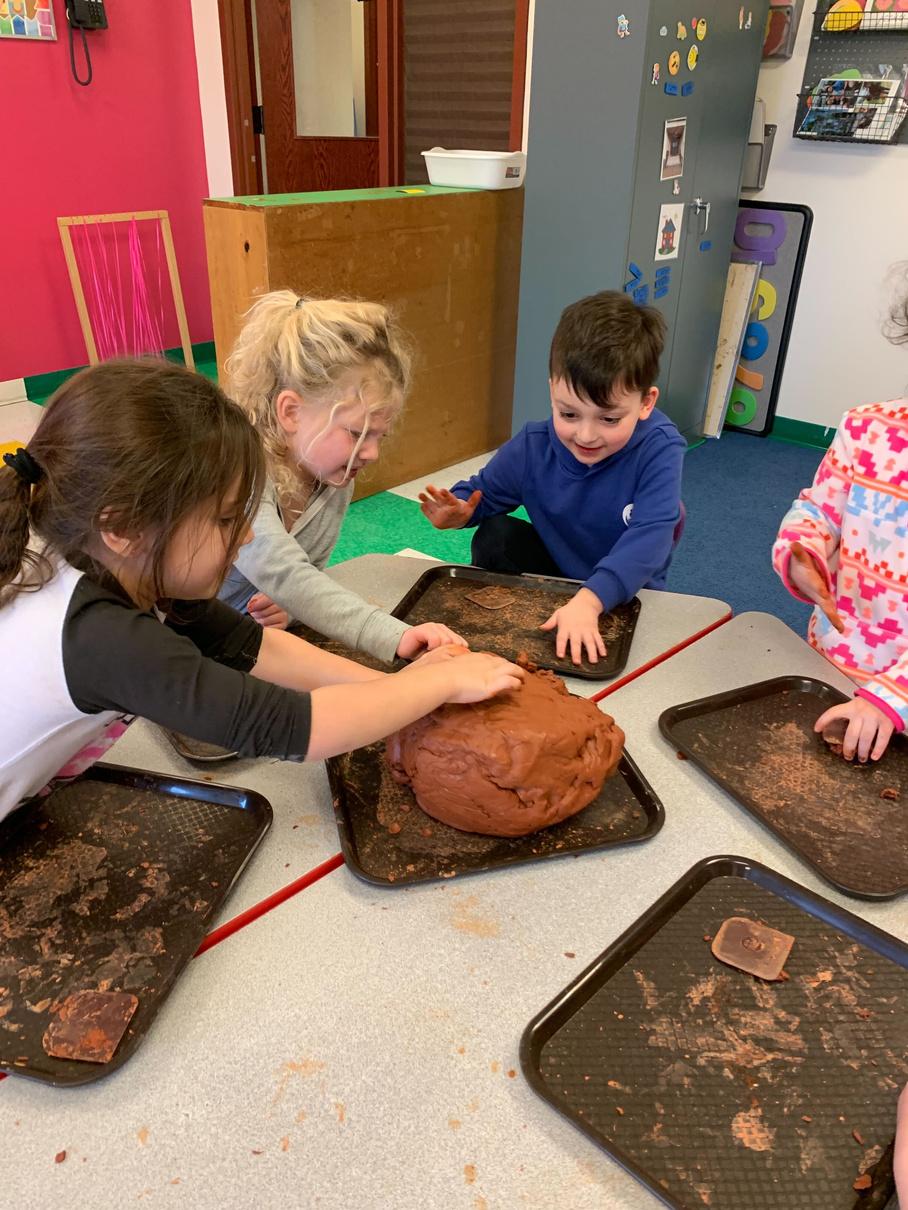
4 minute read
GEULA ZAMIST
Children learn to see the image of the Divine in the other
A fundamental belief of ours is that every child we encounter has tremendous capacity and creativity. Each individual is created b’tzelem Elokim, in the image of God, with the capacity to create something from nothing. This year, teachers have had a unique opportunity to look at the children in this way. We know that as we remove more and more distractions, we can see the essence of the human being. A schoolwide study of clay has given us the opportunity to look closely at our students and see how they engage with this very basic element. As the children poked, pinched, pretended, and asked questions, the teachers observed, documented, and reflected. It has been inspiring for the whole faculty to join together using the same shared material.
Advertisement
Each time the teachers present the children with clay, they share photos and descriptions of the experience with each other on a shared app. In this way, everyone in our school community has a look into what is going on throughout the school.
When we meet, we discuss what we are seeing and share ideas about how to enhance the experience. Teachers have learned so much from the children and from each other. Our learning is deepened as we work with a pedagogical coach who guides our conversations and draws us back to how this investigation aligns with our school values. As the teachers join the children on the journey, they are also taking a journey of enhancing their craft as master observers. The reflections always include language of: I think, I wonder, I hope We are so honored to have educators who continue to think and wonder and hope!
GatherRound is guiding a school-wide extended study focused on child-centered learning, documentation, and reflection, using clay as our inspiration and shared material This experience has elevated the teaching and learning for all children, families, and educators in the community.
Judaism teaches that each human soul is unique in its essence, its capacity, and its mission, yet we all have certain elements in common and share a divine quality at our core From our limited view of existence, we are not able to state that one life is more important than another, even if one’s person’s role or task seems to have an impact on many others, while another’s role may seem infinitely small One person can never take the place of another; one life can never objectively be held as more valuable than another. The Mishnah states (Sanhedrin 4:5): “When a human being makes many coins in the same mint, they all come out the same God makes every person in the same image — God’s image — and each is different ” Elokim is only one of many different names by which God is known in Torah. Many times particular names seem to refer to different aspects of God’s character or behavior. No aspect of God has physical form, however, and God’s fullness remains beyond all description and definition. What does it mean then to be created in the “image” of Elokim?
Elokim is the source of all creative energy, the One who takes from nothing and makes everything According to Torah, it is through the divine will expressed through speech that the entirety of everything we know comes into being. It is an image that addresses our own capacity to create and to shape the world according to our own will. The potential that exists in our power to communicate concepts, form ideas, and manipulate our material world is mind-boggling.
We are able to think, to feel, to reason, to act, to choose, to create We have enormous capacity for dignity, courage, wisdom, and love. It is our powers, the qualities of our soul, that are in the image of the Divine, as opposed to any physical attributes we might possess. Rabbi Harold Schulweiss tells us, “Where there is imago Dei the image of God in us, there is the possibility of imitatio Dei, the imitation of God’s attributes.” We are created both in the image and likeness of God one is given, the other is ours to realize.
Our amazement at our creative capacity, our competency, and our potential must extend beyond our individual selves. We must, in response to our amazement, admit to this same divine potential in everyone we come in contact with. It is easy to see those we love, our families and friends, as unique and valuable individuals; it is harder to see the image of the Divine in the stranger the differently abled; the homeless or infirmed; chose of different nationality, faith, or philosophy. “The supreme challenge is to see God’s image in the one who is not in our image,” said Rabbi Jonathan Sacks This perspective is not always an easy one, but it is more likely to make an impact on the world than others that are easier to live by.
Great growth and enlightenment spring from differences of opinion, healthy tension within respectful dialogue, and arguments l’shem shamayim (literally “for the sake of heaven”). It is from the divine potential in those different from ourselves that we gain both strength and humility. Each person brings a unique contribution to the table. A realization of the unity of humankind beneath surface differences sheds light on the unity of the Divine, which is so central to Jewish belief. Rabbi Yitz Greenberg recognizes three dignities within the understanding of tzelem Elokim: each soul is distinct, of infinite value, and equal to all other souls. The capacity, dignity, and value inherent in each human being — along with a deep appreciation for the areas in which we are remarkably similar to and vastly different from each other — will have a deep impact on our behavior from day to day. Each of us possesses enormous potential and unique gifts. We have both the capacity and the responsibility to acknowledge and realize our own strengths and take advantage of our potential to nurture the divine capacity within others.











